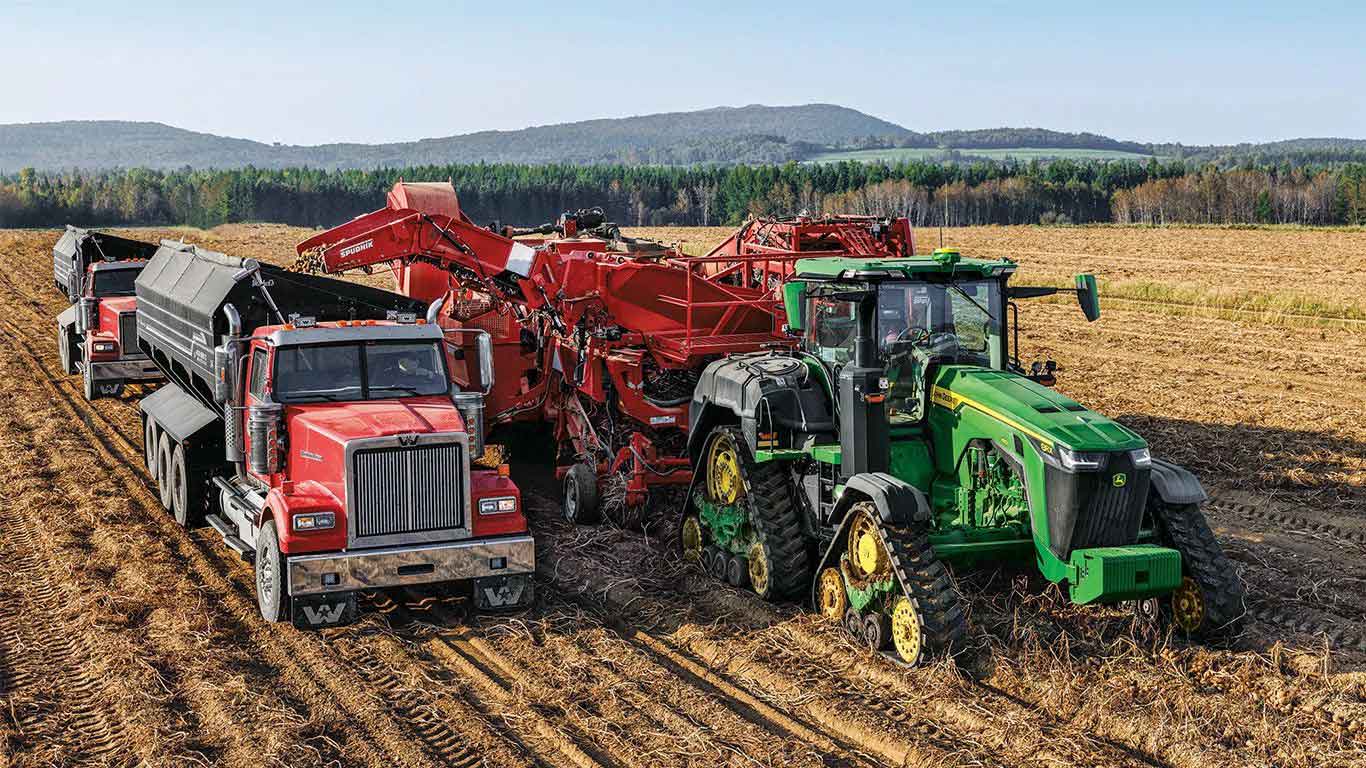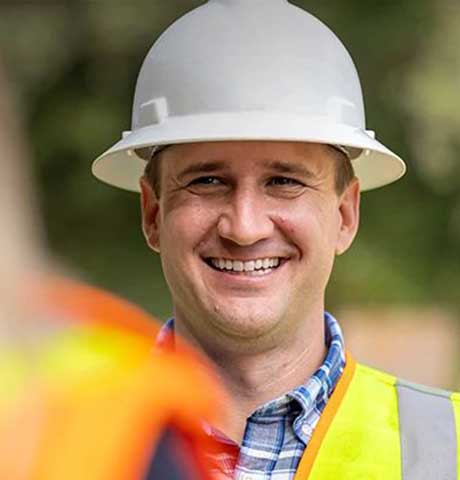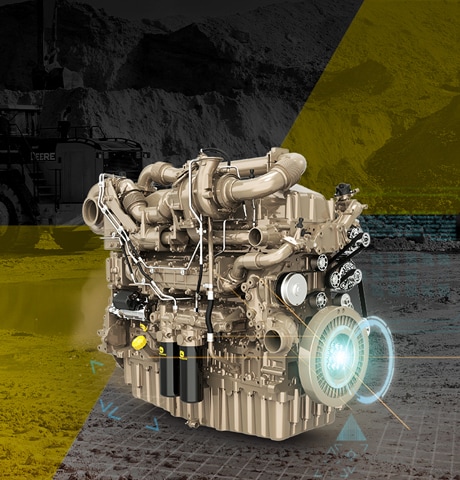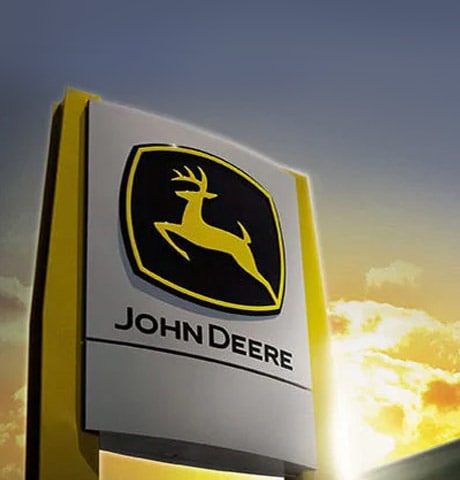Powering Up Potato Harvesting
As hybrid and battery-electric technologies evolve, they are being leveraged to bring power offboarding capabilities and efficiencies to a wide range of applications. Now John Deere is working with Spudnik Equipment Co. to bring those efficiencies to the potato field.
Potato harvesting has a reputation for being a physically demanding and labor-intensive process. Spudnik Equipment Co., a manufacturer of potato and root crop machinery based in North Blackfoot, Idaho, teamed up with John Deere to integrate its Electric Variable Transmission (EVT) technology with the newly developed Implement Control Mode (ICM) in a Spudnik Equipment Co. 6631 3 Row AirSep Potato Harvester. The ICM is a new feature available on John Deere 8 Series tractors equipped with the eAutoPowr™ EVT. The ICM enables the ability to offboard electric power to an implement, such as the cleaning fan on a Spudnik AirSep Potato Harvester. The result is improved efficiency and an optimized harvesting process and crop quality.
This example of engineering ingenuity was awarded the Off-Highway Product Application of the Year award, which highlights unique, technologically advanced, or ground-breaking applications of power systems and/or powertrain components, at the 2024 Power Progress Summit. It also received an AE50 Outstanding Innovation Award, which celebrates product innovations in the areas of agricultural, food, and biological systems, by the American Society of Agricultural and Biological Engineers at its annual Agricultural Equipment Technology Conference.
A Power Balancing Act
A critical step in potato harvesting involves separating the crop from dirt and debris using a powerful air current. In traditional potato harvesters, the fan leverages auxiliary power from the tractor that is also towing the harvester. This means it can be difficult to achieve consistent airflow while also maintaining consistent speeds to match varying harvesting conditions across terrain and load changes.
Matt Porter, owner of Porter Farms in Washburn, Maine, and operator of Spudnik Equipment Co. harvesting equipment, explains, "You either need to increase your rpms, which forces more air through your AirSep, or risk struggling to reach those rpms, resulting in less airflow to the AirSep. This translates to one of two outcomes: either more stones and debris in the load or a greater number of damaged potatoes that won't make it to the final crop."
Inconsistent airflow makes achieving optimal separation a challenge, potentially impacting both potato yield and quality. Operators have to adjust their engine speed to get the fan to speed up or slow down, which in turn takes another variable to manually adjust the fan speed based on the observed soil conditions. This can be a time-consuming and tedious task, requiring vigilance from the operator throughout the harvesting process.

.
This development with Spudnik … demonstrates the new and unique ways electrification can bring increased precision and profitability to customers.
An Electrifying Solution
Spudnik Equipment Co. was looking for a way to address this harvesting challenge by decoupling the harvester functions from the tractor's power take-off (PTO). Together, John Deere and Spudnik Equipment Co. worked to solve the problem by installing a John Deere eDrive Kit, which is powered by the ICM, on the harvester's cleaning fan. This enables the fan speed to be controlled separately from PTO-driven belt speeds; a critical component in the separation of potatoes from unwanted materials like as dirt clods and rocks. With this advancement, the fan speed can be changed with a push of a button, adapting to different soil types and conditions and ultimately reducing the burden on operators.
"When operators make that adjustment, it's easy. Before you were always guessing with your throttle, but with this eDrive kit, operators can adjust that on the fly," says Brent Rigby, regional eastern sales manager for Spudnik Equipment Co. "They can see what the rpm is and ensure it matches what they're after in the field."
Not only do these power offboarding capabilities make the harvesting process more efficient, but operators can now maintain optimal engine speed, ground speed, and airflow to make sure potatoes are harvested effectively while leaving the debris in the field. This independent control reduces the foreign material and bruising of the crop, both increasing harvest value to the potato producer.
Hybridization Takes Root
Advancements like the eDrive Kit and ICM technology from John Deere offer a host of benefits when integrated into high-performing equipment, like a potato harvester.
These new features build upon the EVT technology to provide up to 100 kW of offboard electrical power to eDrive Kits installed on implements. This will bring new levels of precision, automation, and system efficiency to the production system.
"This development with Spudnik is just one example of the breadth of John Deere's electrification strategy," explains Pierre Guyot, senior vice president of John Deere Power Systems. "It demonstrates the new and unique ways electrification can bring increased precision and profitability to customers."
The synergy between Spudnik Equipment Co.'s advanced harvester and the robust John Deere eDrive Kit ushers in a new era of harvesting efficiency and precision. As hybrid and battery-electric technology continues to evolve, the integration of the John Deere ICM and eDrive Kit into a broader spectrum of machinery will help drive innovation and productivity across multiple sectors.


